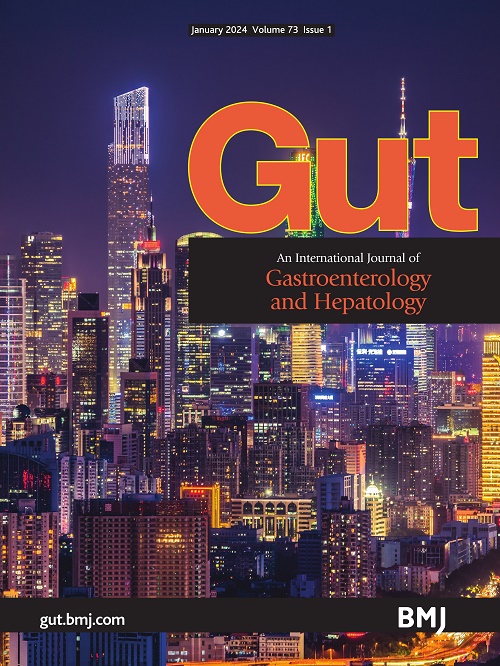大块近端胃GIST肿瘤:伊马替尼缩小肿瘤并随后进行内切术
IF 23
1区 医学
Q1 GASTROENTEROLOGY & HEPATOLOGY
引用次数: 0
摘要
对于大于 3 厘米的胃肠道间质瘤(GIST),由于其具有恶变的可能性,建议进行手术切除,但在胃近端无法进行有限的楔形切除。在贲门等复杂解剖区域,内镜下切除较大病灶在技术上受到限制。我们报告了两例近端(贲门/胃底)巨大 GIST 肿瘤(51 毫米和 60 毫米),经过 3-7 个月的伊马替尼治疗,肿瘤缩小(至 26 毫米和 36 毫米),随后进行了经壁内镜切除。23 个月和 16 个月的随访(包括内镜检查和 CT)结果均无异常。6 欧洲胃肠道内镜学会建议对胃GISTs进行内镜下切除,35毫米的胃GISTs仍具有挑战性。8 位于贲门和胃底等解剖学复杂区域的大型GISTs仍有必要进行手术切除。然而,根治性手术会对贲门功能和患者生活质量构成风险。9 术前伊马替尼可缩小肿瘤、降低有丝分裂活性并降低复发风险。9 10 美国胃肠病学院指南建议新辅助伊马替尼可促进大块 GIST 的肿瘤缩小,提高内镜微创切除的可行性。因此,在此背景下,我们探索了将术前伊马替尼与 EFTR 结合作为治疗大型胃 GIST 的新型微创策略。我们的主要结果表明,这种方法可能是治疗胃解剖复杂区域 GIST 的一种可行的替代方法。病例 1 是一位 65 岁的女性,腹胀和嗳气已有数月之久。胃镜检查显示...本文章由计算机程序翻译,如有差异,请以英文原文为准。
Large proximal gastric GIST tumours: downsizing by imatinib and subsequent endoresection
Surgical removal is recommended for gastrointestinal stromal tumours (GISTs) larger than 3 cm due to their potential for malignancy but limited wedge resection is not possible in the proximal stomach. Endoscopic removal of larger lesions has been technically limited in complex anatomical regions such as cardia. We report two cases of large proximal (cardia/fundus) GIST tumours (51 and 60 mm) which were downsized (to 26 and 36 mm) by 3–7 months of imatinib therapy followed by transmural endoscopic resection. Follow-up of 23 and 16 months including endoscopy and CT was unremarkable. GISTs commonly occur in the stomach.1 2 Due to their malignant potential, surgery is generally recommended.3–5 Recently, endoscopic resection of submucosal tumours (SMTs) has made significant progress.6 The European Society of Gastrointestinal Endoscopy recommended endoscopic resection for gastric GISTs<35 mm projecting into the lumen.3 Endoscopic full-thickness resection (EFTR), an extension of submucosal dissection, has shown promising results for SMTs arising from the deep muscularis propria (MP), particularly in the gastric fundus.7 However, achieving R0 resection in GISTs>35 mm remains challenging.8 Large GISTs in anatomically complex areas such as the cardia and fundus may still necessitate surgical resection.2 Radical surgery, however, poses risks to cardia function and patient quality of life.9 Preoperative imatinib can shrink tumours, reduce mitotic activity and lower recurrence risk.9 10 The American College of Gastroenterology guidelines suggested neoadjuvant imatinib to facilitate tumour reduction in large GISTs, enhancing the feasibility of minimally invasive endoscopic resection. Hence, in this context, we explored the combination of preoperative imatinib with EFTR as a novel, minimally invasive strategy for treating large gastric GISTs. Our primary outcomes suggested this approach may be a viable alternative for GISTs in gastric anatomical complex regions. Case 1 was a 65-year-old woman with abdominal distension and belching for several months. Gastroscopy revealed …
求助全文
通过发布文献求助,成功后即可免费获取论文全文。
去求助
来源期刊

Gut
医学-胃肠肝病学
CiteScore
45.70
自引率
2.40%
发文量
284
审稿时长
1.5 months
期刊介绍:
Gut is a renowned international journal specializing in gastroenterology and hepatology, known for its high-quality clinical research covering the alimentary tract, liver, biliary tree, and pancreas. It offers authoritative and current coverage across all aspects of gastroenterology and hepatology, featuring articles on emerging disease mechanisms and innovative diagnostic and therapeutic approaches authored by leading experts.
As the flagship journal of BMJ's gastroenterology portfolio, Gut is accompanied by two companion journals: Frontline Gastroenterology, focusing on education and practice-oriented papers, and BMJ Open Gastroenterology for open access original research.
 求助内容:
求助内容: 应助结果提醒方式:
应助结果提醒方式:


